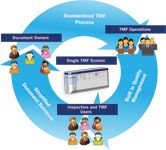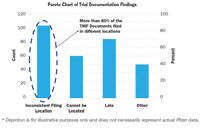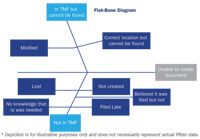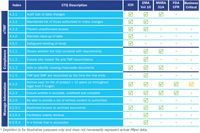Pfizer's Quality by Design Approach to Trial Management
Improving the quality of clinical trials is a major strategic activity for Big Pharma, one where efficient management of a demanding set of regulatory requirements can have a positive impact on the bottom line.
Improving the quality of clinical trials has emerged as a major strategic activity for Big Pharma, one where efficient management of a demanding set of regulatory requirements—not to mention mounting clinical and patient expectations—can have a positive impact on the bottom line. In the following "leading practices" feature, Pfizer outlines how it has employed a management tool first introduced in the automotive sector to enhance its ability to process reams of data from clinical trials to raise the quality of trial submissions, improve regulatory compliance, and avoid costly rework that ultimately impacts speed to market performance for new drugs.

Photo: Thinkstock
Pharmaceutical companies are facing growing quality and compliance concerns because of the increasing complexity of clinical trials and substantial changes in the regulatory environment. To protect patient safety and improve the quality of drugs coming to market, Health Authorities are imposing more stringent requirements and higher levels of scrutiny on companies' compliance with rules and regulations. In 2011, the FDA issued more than twice the number of company warning letters compared to 2005. As a result of greater regulatory hurdles for drug approvals and the need to demonstrate medical differentiation from existing therapies, companies are executing more complex clinical trials in an increasingly cost constrained environment. These challenges have generated an industry-wide imperative to overhaul clinical trial processes in order to improve quality and operational efficiency.
Pfizer experienced the effects of these pressures as keenly as any other company. These challenges were compounded by changes in the company's operating model. These factors created an impetus to change the way it managed clinical trial processes and the approach to quality and risk management. As such, the company embarked on an organization-wide initiative to improve the overall quality of its clinical trials with the ultimate goal of protecting patient safety, adherence to protocols, and ensuring the integrity of clinical data.
One of the key tenets of this initiative is the application of a QbD approach to its clinical trial processes. The concept of QbD was initially developed by the management expert Joseph Juran in the 1970s and later applied to the automotive manufacturing industry. Juran believed that quality could be transformed into a process and that most quality issues can be directly attributable to the way in which quality of the final product was planned. In 2002, the FDA adopted the QbD approach to address quality concerns in the pharmaceutical drug manufacturing process and launched a new initiative called "Pharmaceutical CGMPs for the 21st Century: A Risk Based Approach." As stated in a recent guidance from the FDA, "Quality by design means designing and developing manufacturing processes during the product development stage to consistently ensure a predefined quality at the end of the manufacturing process," (FDA guidance "Q10 Quality Systems Approach to Pharmaceutical GMP Regulations). Pfizer has recently taken the innovative approach of applying QbD principles to its clinical trial processes.
QbD's foundational principle is based on a deep understanding of the process and knowledge of the risks involved. QbD leverages an integrated set of leading edge techniques to build quality into the process by determining critical-to-quality (CTQ) requirements and proactively managing potential risks that are common to the process. The QbD approach focuses on removing waste and reducing variability while driving higher levels of process predictability, excellence, quality, and compliance. This approach enables pharmaceutical companies to achieve sustainable bottom-line benefits, which include avoidance of costly and time consuming rework that can slow down submissions and impact pre-approval inspections. With this in mind, Pfizer is embarking on a broad initiative to apply these same principles to improve the quality of its clinical development processes, starting with the trial master file (TMF).

The redesigned global TMF process.
The trial master file: a case for change
The TMF is the definitive source of clinical trial documentation that provides evidence that patient rights and safety have been protected and that the integrity of the trial data, study analysis, and study conclusions are credible. While the TMF is the primary source of information needed to reconstruct and demonstrate the conduct and validity of a clinical trial, the underlying process of managing and maintaining the TMF for clinical trials is often broken and fragmented. TMFs today, which consist of both electronic and paper document formats, are generally scattered across a large and complex network of clinical trial systems and document repositories. An average clinical trial easily generates 10,000 documents with larger trials producing more than 100,000 documents. This means that a large global pharmaceutical company's TMF can contain millions of documents. With the vast amount of data stored in multiple locations, locating documents becomes particularly challenging, time consuming, and subject to frequent procedural errors. In addition, TMF users and contributors often span different geographies, locations, and functions, making standardization of the TMF processes even more challenging, particularly as pharmaceutical companies begin to heavily outsource their clinical trial execution activities. Finally, with the rapidly changing regulatory landscape and introduction of new requirements, pharmaceutical companies are struggling to maintain compliance with regulatory expectations and requirements for the TMF.
In recent inspections across a number of pharmaceutical companies, regulatory health authorities, including the MHRA, EMA, and FDA, have placed a higher level of scrutiny on the TMF as supporting evidence that appropriate procedures were being followed during a clinical trial. Pharmaceutical companies and CROs alike have struggled to maintain regulatory compliance and have often been cited for inability to provide a full TMF for inspection. As a result, the industry is making a concerted effort to address these challenges and meet regulatory requirements. One notable example is a multi-year effort led by a Drug Information Association working group that established a common TMF reference model. This group, comprised of participants from more than 150 pharmaceutical companies including Pfizer, as well as regulatory agencies such as the FDA and MHRA, has helped drive standardization across the industry. The discussion and activity around the TMF continue to gain momentum, as evidenced by a number of industry conferences focused specifically on the TMF this year, which has more than tripled compared to two years ago.
Pfizer's response
Pfizer addressed the challenges it faced with the TMF by overhauling its processes and technology systems. The decision to utilize the QbD approach rather than other standard process improvement methodologies was based on the desire to achieve "zero defects" in its TMF by building quality into the process. In the specific application of QbD to Pfizer's TMF process, the TMF was treated as the "end product," with a focus on designing the process to reduce the number of defects, i.e. missing or incorrect documents. Though the premise of building quality into the TMF process and routinely monitoring it to enable consistent quality may seem simple and even basic, it is a paradigm shift for the industry. For many companies, the TMF has traditionally been a "graveyard" repository of clinical trial documents filed as an afterthought and relatively forgotten until the time of an audit or inspection. In an effort to reduce the overall cost of poor quality, Pfizer has developed a dynamic solution which enables active contribution, organization, maintenance, and monitoring of TMF documents. As part of the solution, Pfizer has built the necessary controls and measures to proactively manage quality in real time.

TMF process redesign effort included four key steps.
Pfizer's TMF solution overview
Pfizer's first step was to assign a dedicated process owner to manage the TMF process redesign, implementation, and ultimately, serve as the single point of accountability for the TMF. A cross-functional team was also convened to support the redesign and implementation of the new TMF solution.
The heart of the redesign is a standardized process enabled by a custom technology solution. The solution allows users to easily access documents through a single interface across all business units, functions, and countries. It also provides the organization the ability to monitor TMF quality for all studies, including those that are outsourced to clinical research organizations. For long-term sustainability, Pfizer created a support infrastructure staffed by resources who guide study teams in the management of the TMF. Additionally, a dedicated group of offshore resources was established to conduct quality control of documents submitted to the TMF. This integrated solution provided the necessary process controls and measures to help Pfizer move towards achieving "zero defects" in its TMF.

The Pareto Chart was used to identify critical areas for RCA.
Redesigning Pfizer's global TMF process
By leveraging the QbD methodology and tools, Pfizer was able to develop a deep understanding of customer requirements (both internal and external stakeholders, including regulators and inspectors) and design a process that met those requirements. The overall TMF process redesign effort included four key steps as described below.

Fishbone diagrams were developed to identify root causes for prioritized TMF Issues.
Assess
The development of a new TMF process began with defining the desired end state of the TMF and its associated quality characteristics. To that end, Pfizer employed a number of QbD tools, including a voice of business analysis to better understand and elicit the needs of its internal business stakeholders (TMF contributors and users) as well as a voice of customer analysis to determine the requirements of its external customers, namely regulators and inspectors. Additionally, a root cause analysis (RCA) was performed to systematically understand the issues and determine the underlying factors and causes that contributed to any existing quality concerns (e.g., inconsistent filing locations for TMF documents). The RCA was used as a key input to the design efforts as solutions were incorporated in the new process to correct or eliminate the causes, and prevent similar quality issues from recurring. Several process improvement tools were used in the RCA including the fish-bone diagram which helped the team systematically analyze cause and effect relationships and the Pareto chart which provided insights into the vital factors causing the most issues within the TMF. By concentrating the efforts on the most critical issues, the team was able to focus resources on the areas that have the greatest impact on quality. The results of the assessment phase provided key information to inform the design of the TMF process and technology solution.
Design
The output from Pfizer's assessment of the TMF, coupled with regulatory requirements and industry standards, served as input to defining the critical to quality (CTQ) attributes. CTQs were used to establish the connection between key customer requirements and quality criteria for the new TMF process. Pfizer took the extra step to map the CTQs against major regulatory requirements (Table 1). For example, the ability to identify missing documents was determined to be a critical requirement. As a result, Pfizer designed into its process, continual identification of document placeholders with associated due dates driven by milestone or events to help detect missing documents. Establishment of CTQs enabled the team to design a process that met both regulatory and business critical requirements, leading to consistent delivery of a quality product—the TMF.

Table 1: Categorized critical-to-quality (CTQ) elements mapped to the requirements of regulatory health authorities.
Before finalizing the new TMF process, the design team conducted a failure modes and effects analysis (FMEA) to understand potential failure points in the process and incorporate necessary measures to prevent such failures from occurring. The FMEA not only exposed potential failures but also the root causes and consequences of those failures. Examples of potential failure points included poor document quality and delays in error correction which have downstream impact on timely submission of documents and the completeness of the TMF. This analysis allowed the team to determine necessary refinements to the design of the process to avoid potential issues and assure the highest possible quality and reliability in the new process.
Monitor and control
Finally, in order to proactively monitor the new TMF process, key quality control measures were implemented per metrics defined by the CTQ dimensions. The CTQs were rolled up into three key performance indicators: completeness, document quality, and timeliness. Control points were established at key trial milestones which provide real-time feedback on quality performance to study teams and to line management. This enables active management of quality by providing transparent line of sight into quality—when correction requires the least amount of effort. These built-in controls and management reports are used throughout the lifecycle of a study, enabling proactive and continual performance management. As a result, study teams and management have a high level of visibility in monitoring and securing overall TMF quality. This approach also drives increased accountability across the organization.
Bottom line: What was achieved
Little more than a year since the launch of the new TMF process and technology solution, Pfizer has witnessed significant improvements across all three measures of TMF health—completeness, document quality, and timeliness. In particular, TMF completeness—a measure of the presence of required TMF documents at any given point in the trial—improved by more than 50 percent and is progressing well toward meeting established TMF performance targets. More important, for the first time in Pfizer's history, the entire organization has clear visibility into the status of the TMF and is able to intervene in a timely manner to enable quality.
The application of QbD principles to clinical trial processes has provided Pfizer the unique opportunity of achieving the consistent quality demanded by regulators, while reducing operational cost and burden. Pfizer's application of QbD principles to the TMF process is a powerful example of this, and the organization is now extending this approach to other clinical trial processes, including protocol development, data management and regulatory submission management. The key outcome has been increased transparency and real-time visibility into process quality. This ability to actively monitor and control quality reduces regulatory risk, protects patient safety, and results in operational benefits that avoid costly and time-consuming rework, which ultimately increases speed to market and, more importantly, brings medicines to the patients who need them.

Ivan Walrath is TMF Process Owner, Senior Director, Development Operations at Pfizer. He can be reached at ivan.p.walrath@pfizer.com. Coleen Glessner is Head of Clinical Trial Process and Quality, Vice President, Development Operations at Pfizer. She can be reached at Coleen.Glessner@pfizer.com. Amy Cheung is a Senior Manager at Deloitte Consulting. She can be reached at amyycheung@deloitte.com. Dan Ressler is Principal at Deloitte Consulting. He can be reached at dressler@deloitte.com.

FDA Grants Priority Review to Regeneron’s Eylea for Macular Edema Following Retinal Vein Occlusion
April 18th 2025Regulatory action was based on data from the Phase III QUASAR trial, which demonstrated that Eylea HD dosed every eight weeks achieved non-inferior visual acuity outcomes compared to Eylea in patients with macular edema following retinal vein occlusion.
Addressing Disparities in Psoriasis Trials: Takeda's Strategies for Inclusivity in Clinical Research
April 14th 2025LaShell Robinson, Head of Global Feasibility and Trial Equity at Takeda, speaks about the company's strategies to engage patients in underrepresented populations in its phase III psoriasis trials.
Amgen’s Imdelltra Demonstrates Significant Overall Survival Improvement in Small Cell Lung Cancer
April 16th 2025In the Phase III DeLLphi-304 trial, patients with small cell lung cancer administered Imdelltra achieved a statistically significant and clinically meaningful improvement in overall survival compared to standard-of-care chemotherapy.